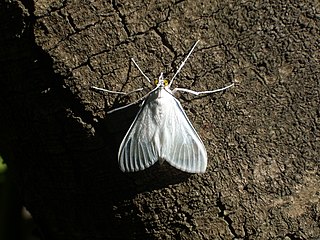
Honduras, officially the Republic of Honduras, is a country in Central America. In the past, it was sometimes referred to as "Spanish Honduras" to differentiate it from British Honduras, which later became modern-day Belize. The republic of Honduras is bordered to the west by Guatemala, to the southwest by El Salvador, to the southeast by Nicaragua, to the south by the Pacific Ocean at the Gulf of Fonseca, and to the north by the Gulf of Honduras, a large inlet of the Caribbean Sea.

The Honduras national football team nicknamed Los Catrachos, La Bicolor or La H, is governed by the Federación Nacional Autónoma de Fútbol de Honduras (FENAFUTH). To date, the team has qualified three times for the FIFA World Cup, in 1982, 2010 and 2014.
Asturodes is a genus of moths of the family Crambidae. It contains only one species, Asturodes fimbriauralis, which is found in Brazil, Peru, Costa Rica, Belize, Honduras, Puerto Rico, Jamaica and Cuba.
Bonchis munitalis is a species of snout moth in the genus Bonchis. It was described by Julius Lederer in 1863, and is known from Honduras, the Dominican Republic, Brazil and Venezuela. It is also found in the southern United States.
Hyperparachma bursarialis is a species of snout moth in the genus Hyperparachma. It was described by Francis Walker in 1866, and is known from Honduras, Venezuela, the West Indies and Brazil.
Argyractoides leucogonialis is a moth in the family Crambidae. It is found in Panama and Honduras.
Oxyelophila puralis is a moth in the Crambidae family. It was described by Schaus in 1912. It is found in Costa Rica and Honduras.
Parapediasia tenuistrigatus is a moth in the family Crambidae. It was described by Zeller in 1881. It is found in Colombia and Honduras.
Hyalorista limasalis is a moth in the family Crambidae. It is found in Honduras.
Hyalorista opalizalis is a moth in the family Crambidae. It is found in Honduras and Brazil.
Munroeodes thalesalis is a moth in the family Crambidae. It was described by Francis Walker in 1859. It is found in Honduras.
Apilocrocis excelsalis is a moth in the family Crambidae. It was described by Schaus in 1912. It is found in Costa Rica and Honduras, south to Argentina.
Cnaphalocrocis cochrusalis, the marasmia moth, is a moth in the family Crambidae. It is found in the West Indies, Costa Rica, Honduras and the United States, where it has been recorded from Florida, Louisiana, Mississippi, Oklahoma, South Carolina and Texas.
Gonocausta zephyralis is a moth in the family Crambidae. It was described by Lederer in 1863. It is found in Indonesia, Ecuador, Costa Rica and Honduras.
Microphysetica hermeasalis is a moth from the family Crambidae. The moth was discovered by Francis Walker in 1859, and it is found in Venezuela, Mexico, Central America, the Antilles and Florida. Its wingspan is 9–10 mm. Adults are on wing from March to June and from November to December in Florida.

Palpita flegia, the satin white moth, is a moth in the family Crambidae. It was described by Pieter Cramer in 1777. It is found in Suriname, Colombia, Brazil, Honduras, Nicaragua, Costa Rica, Panama, Mexico, the Caribbean and the United States, where it has been recorded from Alabama, Florida and Texas.
Phostria mapetalis is a moth in the family Crambidae. It was described by Schaus in 1912. It is found in Costa Rica and Honduras.
Spilomela discordens is a moth in the family Crambidae. It is found in Panama, Costa Rica and Honduras.
Syllepte belialis is a moth in the family Crambidae. It was described by Francis Walker in 1859. It is found in Brazil, Honduras, Costa Rica, Jamaica, Puerto Rico and Cuba.
Trichaea pilicornis is a moth in the family Crambidae. It was described by Gottlieb August Wilhelm Herrich-Schäffer in 1866. It is found in Mexico, Guatemala, Panama, Honduras, Costa Rica, Cuba, Ecuador, French Guiana, Brazil and Argentina.





